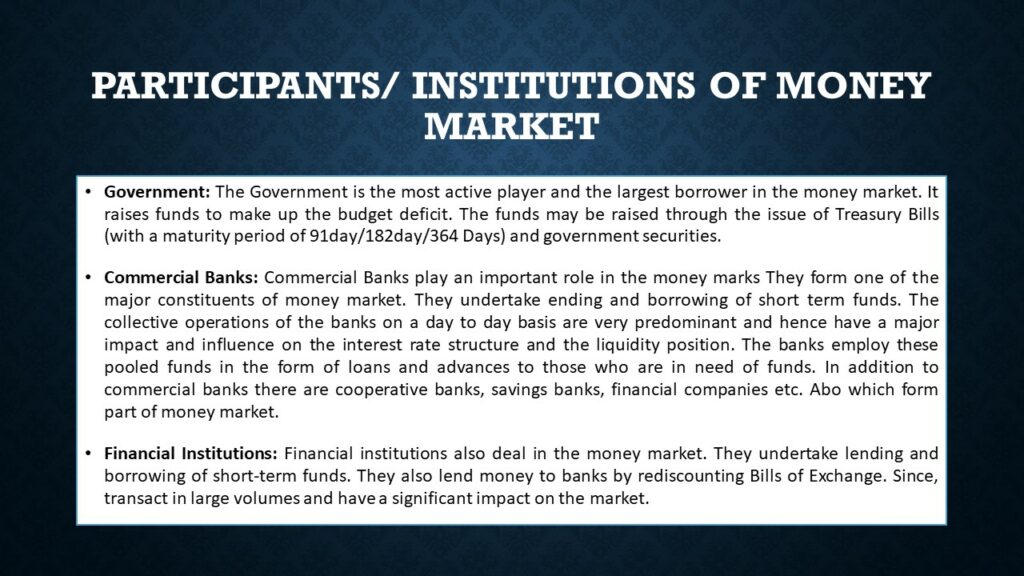INSTITUTIONS/ PARTICIPANTS OF MONEY MARKET
The institutions of money markets are those which deal in lending and borrowing of short term funds. The institutions of money market are not the same in all the countries of the world, rather they differ from country to country. The commercial banks, central banks, acceptance houses, non-banking financial intermediaries (NBFI), brokers, etc. Are the major institutions of money market.
| PLAYERS | ROLE |
| Central Bank | Intermediary |
| Government | Borrowers/ Issuers |
| Bank | Borrowers/ Issuers |
| Discount houses | Markets |
| Financial institutions | Borrowers/ Issuers |
| Mutual funds | Lenders/ Investors |
| FII’s | Investors |
| Dealers | Intermediaries |
| Corporate | issuers |
These are discussed as under:
Reserve Bank of India: The Reserve Bank of India is the most important player in the Indian Money Market. The Organized money market comes under the direct regulation of the RBI. The RBI operates in the money market is to ensure that the levels of liquidity and short-term interest rates are maintained at an optimum level so as to facilitate economic growth and price stability.
RBI also plays the role of a merchant banker to the government. It issues Treasury Bills and other Government Securities to raise funds for the government. The RBI thus plays the role of an intermediary and regulator of the money market. An important point is that the performance of the central bank depends on the character and composition of money market. But the central bank does not enter into direct transaction, it controls the money market through changes in the bank rate and open market transactions.
Government: The Government is the most active player and the largest borrower in the money market. It raises funds to make up the budget deficit. The funds may be raised through the issue of Treasury Bills (with a maturity period of 91day/182day/364 Days) and government securities.
Commercial Banks: Commercial Banks play an important role in the money marks They form one of the major constituents of money market. They undertake ending and borrowing of short term funds. The collective operations of the banks on a day to day basis are very predominant and hence have a major impact and influence on the interest rate structure and the liquidity position. The banks employ these pooled funds in the form of loans and advances to those who are in need of funds. In addition to commercial banks there are cooperative banks, savings banks, financial companies etc. Abo which form part of money market.
Financial Institutions: Financial institutions also deal in the money market. They undertake lending and borrowing of short-term funds. They also lend money to banks by rediscounting Bills of Exchange. Since, transact in large volumes and have a significant impact on the market.
Corporate Firms: Corporate firms operate in the money market to raise short-term funds to meet their working capital requirements. They issue commercial papers with a maturity period of 7 days to 1 year. These papers are issued at a discount and redeemed at face value on maturity. These corporate firms use both organized and unorganized sectors of money market.
Institutional Players: They Consist of Mutual Funds, Foreign Institutional Players, Insurance Firms, etc. Their level of Participation depends on the regulations. For instance; the level of participation of the Foreign Institutional Investors (FIIs) in the Indian money market is restricted to investment in Government Securities.
Discount Houses and Primary Dealers: They are the intermediaries in the money market. Discount Houses discount and rediscount commercial bill and Treasury Bills. Primary Dealers were introduced by RBI for developing an active secondary market for Government securities. They also underwrite Government Securities.
Participants of Money market ; Participants of money market instruments ; Participants of money market ppt ; Participants of money market instruments



